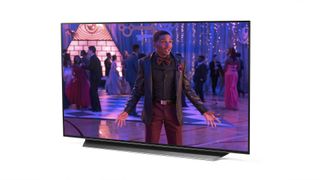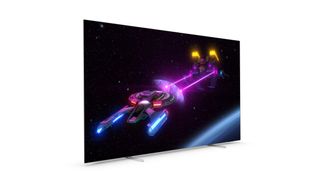The TV market is in an almost frantic state of flux. That's partly because we’ve got an unprecedentedly wide range of different screen technologies vying for our attention, and partly because we’re in that strange time of the year when the latest new TVs are sharing shop space with last year’s models – the latter of which can often be found going for knock-down prices.
With so much going on, we want to make it as easy as possible for you to find the very best TV deals in town. To that end we’re constantly trawling stores, online and off, in an exhaustive search for TV deals that combine high performance with great value.
This week our research has hammered home that while it’s all too easy to have your head turned by the latest dazzling high-brightness OLED, Mini LED, QLED or even QD-OLED TVs, the best TV deal in town right now is actually a 2021 set now discounted to a frankly irresistible price. And that model is [drum roll please]… the Philips 55OLED806.
How good is this deal?
The 65-inch sibling of the 55-inch Philips 55OLED806 blew us away when we looked at it last October, despite at that time costing £2299 (around $2800). This 55-inch model was £1599 (around $1950) back then, so the fact that it's now available for just £899 (around $1090) thus seems almost too good to be true.
To put that price in a wider context, at the time of writing LG’s OLED55C1 OLED TV from 2021 is £999 / $1100 (this is the TV to buy this week if you're in the US, where Philips OLEDs aren't available); the new LG OLED55C2 costs nearly twice as much, at £1699 / $2000; and even Sony’s lower-specified XBR-55A80J from 2021 costs £1179 / $1330.
What makes this TV so good?

There are many reasons why Philips’ OLED806 series bagged not just maximum five-star reviews from us but also two coveted What Hi-Fi? annual product awards. The most important one, though, has to be its picture quality.
The fact that it’s an OLED TV gets it off to a great start. The way each and every pixel in an OLED screen makes its own light immediately gives it a fantastic advantage when it comes both to reproducing intensely deep black levels, and delivering small bright highlights within those intensely dark areas. The OLED806, though, takes these core OLED advantages and turns them up to 11 thanks to its P5 picture processing engine.
We’re now into the fifth generation of this potent image analysis and enhancement system, and the improvements its varied and carefully ordered processes introduce can be felt in pretty much every frame of any source you care to throw at it.
Particularly outstanding is how much intensity the screen gets out of bright HDR highlights compared with most OLED TVs, without damaging the technology’s trademark gorgeously deep black levels. This makes HDR pictures feel both more intense, dynamic and lifelike than some OLED TVs costing more than twice as much.
It backs these highlights up, too, with exceptionally rich and intense colours that underline the joys of the HDR and wide-colour-gamut imagery now widely available from disc or video streaming services. The latest processor ensures, as well, that these unusually vibrant colours are now delivered with much more balance and nuance than they used to be with Philips TVs. The vividness is therefore delivered without tipping pictures over into looking forced and unnatural, and enhances rather than flattens an image’s sense of depth.
A special skin tone analyser ensures that the P5 processor’s colour enhancements don’t leave faces looking artificial or overcooked, and the new colour refinement also partners up beautifully with Philips’ long-running talents when it comes to delivering some of the sharpest and most textured images in the 4K TV world. What’s more, thanks to some stellar upscaling processing, this sharpness remains outstanding even when you’re watching HD sources.
The extreme clarity remains intact when there’s motion to contend with, too, thanks to Philips’ newly improved, far more sensitive motion processing, and despite the undoubted potency of the P5 processor, the image enhancements now deliver their multitude of improvements without causing anything like as many unwanted digital processing side effects as we used to see with Philips TVs.
The OLED806’s desire to please sees it being one of a still-small group of TVs capable of supporting both the HDR10+ and Dolby Vision ‘premium’ HDR formats alongside the standard HDR10 and HLG formats. This means that the 55OLED806 will be able to give you the best results possible from any source you care to feed it.
It's a great next-gen gaming TV, too

Cutting-edge gaming is catered for, too, with support over two HDMIs for 4K/120Hz feeds, VRR (including Freesync) and ALLM.
Smart features come courtesy of an unusually stable and slick implementation of Google’s Android TV platform, with Philips going the extra mile to ensure that it includes the catch-up services for all of the main terrestrial broadcasters – as well, of course, as big subscription-hitters such as Netflix, Disney+, Amazon Prime Video, Apple TV, Spotify, Tidal and Amazon Music.
The Philips 55OLED806’s outstanding pictures are supported by a surprisingly (given how slim the TV is) credible sound system. There’s enough bass around to give even bombastic movie soundtracks genuine weight, yet the main stereo drivers are also powerful and lively enough to deliver good detailing and vocal management together with a pleasingly open and nimble mid-range without being overwhelmed by the bass.
Downside? You need to tweak some settings to get it performing its best
If there’s an issue with the 55OLED806, it’s that you have to work a bit harder than you ideally would to always get the very best out of it. Some of the picture presets can be a bit over-enthusiastic at times with their application of some aspects of the 55OLED806’s processing, and different sources can sometimes generate different issues you need to compensate for in the 55OLED806’s set-up options. All of which means that you’ll need to familiarise yourself with and commit to regularly revisiting the TV’s rather labyrinthine onscreen menus.
This seems like a seriously small price to pay, though, for a TV that gives you so many features and so much all-round performance quality for just £899. There’s simply no other TV around right now that gives you so much bang for so little buck.
Also consider...

If you love the sound of this deal but the size isn't quite right for you, you'll be delighted to hear that both the 48-inch and 65-inch versions of the Philips OLED806 are also currently available with massive discounts.
If you're reading this from the US, where Philips OLEDs aren't available, or you're after a TV that requires less in the way of jiggery-pokery with the settings and/or one with four HDMI 2.1 sockets, you need to check out the LG OLED55C1, which is also now available at almost its lowest-ever price.
If you want an aggressively bright picture for a really light room, you could consider the Samsung QE55QN90A – a Mini LED TV that’s again getting discounted now due to it launching in 2021. This doesn’t deliver quite as much local contrast purity and punch as the Philips model.
You'll see the latest, lowest prices for all of these models in the box below.

